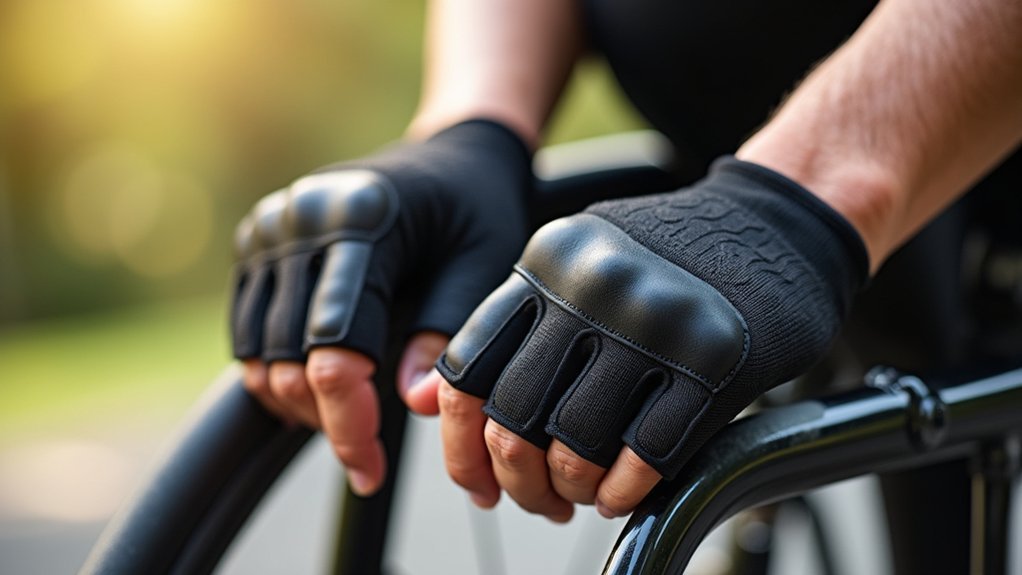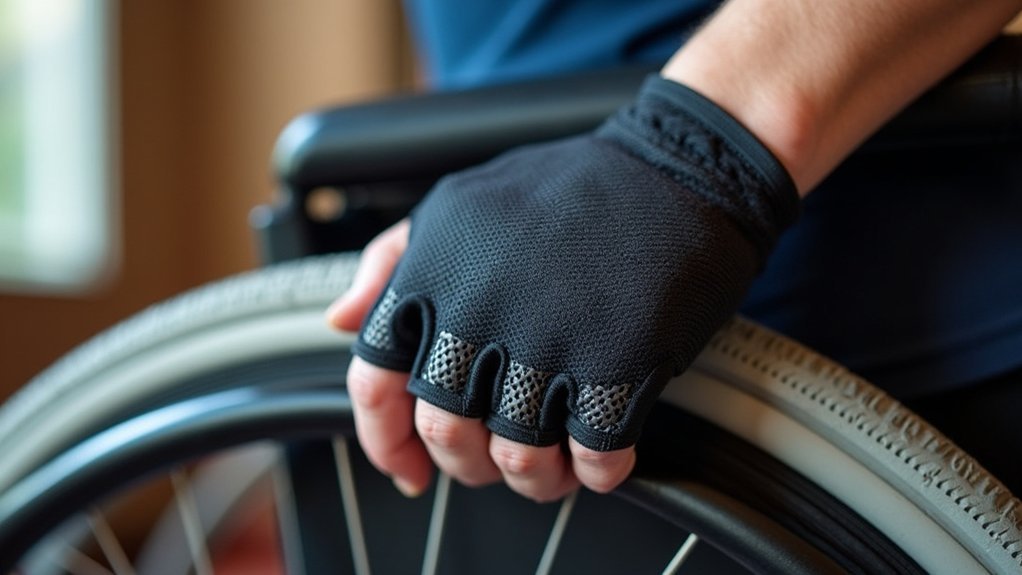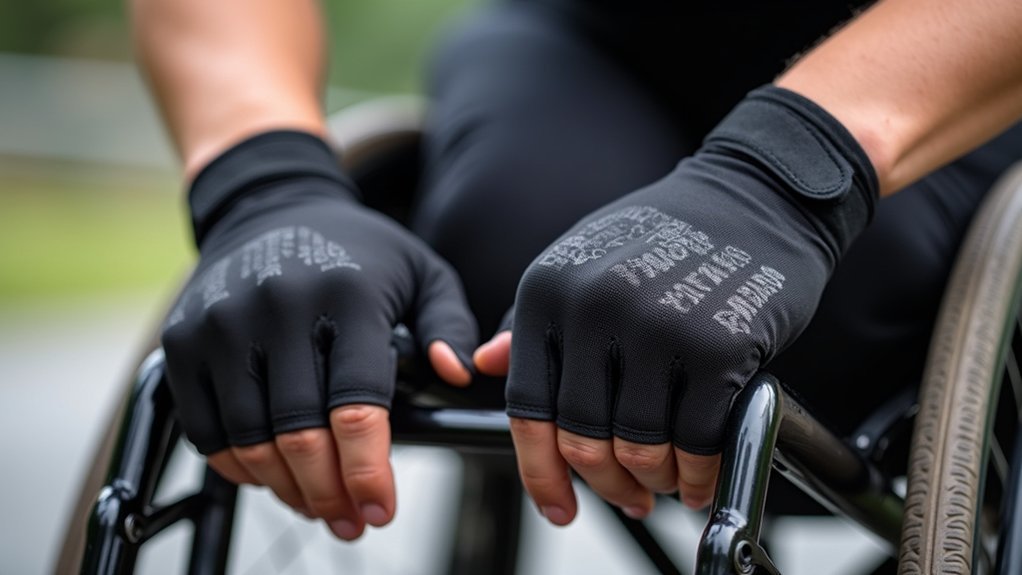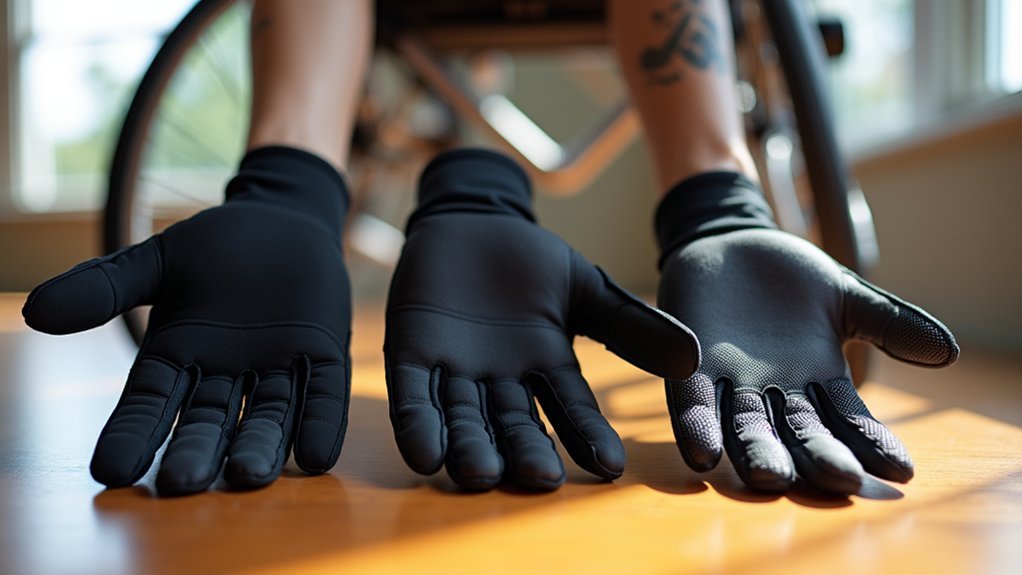You’ve likely experienced the frustration of slipping hands during a wheelchair push or the discomfort of blisters after a long training session. Finding the right gloves isn’t just about comfort—it’s essential for your performance and long-term hand health. Whether you’re a competitive athlete or daily user, your choice of hand protection can make the difference between painful limitations and achieving your full potential. Let’s explore three top options that could transform your wheelchair experience.
Wheelchair Gloves Half-Finger with Anti-Blister Padding

Wheelchair athletes seeking both protection and dexterity will find the Half-Finger Anti-Blister Padding gloves invaluable for daily training and competition. These gloves feature strategically placed padding that prevents blisters while absorbing shock during intense pushing.
You’ll appreciate the open fingertips that let you use touchscreens without removing your gloves. The reflective stripes boost your visibility in low light conditions.
Size up when ordering as they typically run small. Two fingers include elastic extensions for easy removal. Users from veterans to gym enthusiasts praise their comfort, durability, and how well they stay in place during rigorous activity.
Best For: Wheelchair athletes and users who need palm protection and blister prevention while maintaining fingertip dexterity for touchscreen devices.
Pros:
- Open fingertips allow touchscreen use without removing gloves
- Strategically placed padding provides effective blister prevention and shock absorption
- Reflective stripes enhance visibility in low light conditions
Cons:
- Sizes run small, requiring customers to order one size larger than usual
- Limited finger coverage may not be suitable for cold weather use
- Some users may find the initial fit uncomfortable until the gloves are broken in
Rebz Wheelchair Gloves for Men (Full Thumb Active Lifestyle Gloves)
Paraplegic athletes seeking reliable hand protection will find Rebz Full Thumb Gloves an excellent option, especially when durability is a priority. The heavy-duty soft leather construction offers superior padding and withstands extensive use with minimal wear.
You’ll appreciate the comfortable fit and excellent grip in both wet and dry conditions. However, be aware of the wide Velcro cuff that might interfere with wristwatches, and some users report strap issues during intense activities.
Many athletes dislike the prominent handicap logo. Despite this drawback, the gloves deliver exceptional performance for sore hands and represent the best option many wheelchair users have found.
Best For: Paraplegic athletes and active wheelchair users who need durable, comfortable gloves with full thumb coverage and superior padding for extended daily use.
Pros:
- Made from quality heavy-duty soft leather with excellent padding and durable stitching for long-lasting performance
- Provides superior grip in both wet and dry conditions with minimal wear after extensive use
- Comfortable fit that conforms well to hands, offering relief for sore and aching hands
Cons:
- Features a prominent handicap logo that many users dislike as it advertises their disability
- Wide Velcro cuff/fastener may interfere with wristwatches and some users report the strap coming apart during intense activities
- Some users experienced inconsistent durability, with at least one report of ripping after less than three hours of use
Inspired Comforts Fingerless Wheelchair Gloves with Anti-Slip Grip

Athletes seeking ideal control without sacrificing dexterity will find Inspired Comforts Fingerless Wheelchair Gloves an excellent choice for daily use and competitive sports. Their advanced anti-slip technology guarantees secure grip while propelling, even during intense activities.
The breathable fabric keeps your hands cool while strategically placed padding reduces fatigue during extended sessions. With ambidextrous design and extra leather reinforcement on high-wear areas, these gloves balance durability with comfort.
Users rate them 4.5/5 stars, praising their grip quality and construction. Note that some report a tight initial fit, though the leather typically stretches with use. Consider sizing up for maximum comfort.
Best For: Wheelchair users, athletes, and individuals with mobility aids who need reliable grip and hand protection while maintaining finger dexterity for daily tasks and sports activities.
Pros:
- Advanced anti-slip technology provides exceptional grip and control while propelling wheelchairs
- Breathable fabric with strategic padding reduces hand fatigue during extended use
- Durable leather reinforcement on high-wear areas extends product life while maintaining flexibility
Cons:
- Sizing runs small according to multiple customer reviews, potentially requiring users to order a size up
- Initial tight fit may cause discomfort until leather stretches with regular use
- Some customers reported expectations for better quality and more padding than provided
Factors to Consider When Choosing Gloves for Wheelchair Athletes: Grip Enhancement Review

When choosing wheelchair gloves, you’ll want to weigh the benefits of full versus half-finger designs based on your specific sporting needs. Your comfort depends largely on proper padding placement and effective anti-slip grip technology that prevents hand fatigue during intense competition. Finding the right size is essential—too tight restricts blood flow while too loose compromises control, so measure your hands carefully before purchasing.
Subheading Discussion Points for Wheelchair Athletes’ Gloves
Because propulsion efficiency can make the difference between victory and defeat, grip enhancement stands as perhaps the most critical factor when selecting wheelchair athletic gloves. You’ll want to prioritize anti-slip technology that provides consistent traction regardless of weather conditions or sweat levels.
Consider materials carefully—durable leather offers longevity but may sacrifice breathability, while synthetic fabrics typically enhance ventilation during intense activity. Examine padding placement closely; effective cushioning should protect pressure points without bulking up areas that require dexterity.
For everyday athletes, fingerless designs deserve special consideration. They’ll give you the tactile sensitivity needed for operating phones and handling small objects while maintaining essential palm grip for wheelchair propulsion. This balance between performance and practicality often proves ideal for athletes who shift frequently between competition and daily activities.
Full vs. Half-Finger Design
Two distinct designs dominate the wheelchair athletics glove market: full-finger and half-finger models. Your choice between these options should reflect your specific needs and environmental conditions.
Half-finger designs offer superior dexterity, allowing you to handle electronics without removing your gloves. They’re also more breathable and retain less heat, making them ideal for extended use during competitions in warmer weather.
Full-finger models provide extensive protection against environmental elements and potential injuries. They enhance grip across the entire hand and offer additional support during intense propulsion phases of wheelchair racing or basketball.
Consider your sport’s demands carefully—basketball players might prefer the tactile feedback of half-finger designs, while outdoor racers facing variable weather conditions might benefit from full-finger protection. Your comfort and performance requirements should guide this essential decision.
Padding Placement Matters
Strategic padding placement represents one of the most critical factors in selecting effective wheelchair athletics gloves. When you’re pushing your chair for extended periods, properly positioned padding considerably reduces pressure points and prevents hand fatigue, allowing you to maintain peak performance longer.
Look for gloves with padding strategically placed in the palm and finger areas, as these designs absorb shock while enhancing your grip control through improved friction. Well-designed padding distributes weight evenly across your hands, minimizing injury risk and extending your gloves’ lifespan.
You’ll notice the difference immediately during training sessions—athletes consistently report that gloves with ideal padding placement enable longer workouts with less discomfort. The right padding doesn’t just protect your hands; it transforms your pushing efficiency and overall athletic performance.
Anti-Slip Grip Technology
Anti-slip grip technology represents the next frontier in wheelchair athletics gloves, complementing well-placed padding with enhanced control during propulsion. You’ll notice the difference immediately when using gloves featuring rubber dot pads or textured surfaces designed specifically to prevent slippage in various conditions.
These advanced materials don’t just improve traction—they actively reduce hand fatigue during extended training sessions or competitions. The strategic placement of these grippy elements works in harmony with padding to distribute pressure evenly across your palms.
When you’re competing, you can’t afford to worry about your hands slipping. Athletes consistently report greater confidence in their maneuverability when using gloves with quality anti-slip features. This enhanced stability translates directly to improved performance and safety, particularly during high-intensity competitive situations.
Size Selection Strategies
Finding the perfect glove size stands as one of the most essential yet overlooked aspects of wheelchair athletics equipment. When shopping, you’ll likely need to select one size larger than your typical measurement, as athletic gloves commonly run small.
Pay close attention to user reviews discussing fit consistency, since identical size labels don’t guarantee uniform sizing across different models. Look for design elements that enhance adjustability—straps that tighten or elastic sections that expand can accommodate various wrist sizes and improve overall comfort.
Materials with stretch properties are worth considering, as they’ll conform to your unique hand shape over time. If possible, try gloves on before purchasing, as individual hand proportions greatly impact performance. Your hands’ specific dimensions and shape can make the difference between merely adequate and truly performance-enhancing gear.
Weather Adaptability Features
While dedicated athletes train in all conditions, your wheelchair gloves must keep pace with whatever Mother Nature throws your way. Look for water-resistant materials that maintain grip even in wet conditions, guaranteeing your performance doesn’t suffer during rain showers.
Breathable fabrics are essential for temperature regulation, preventing sweaty hands during intense workouts while still providing necessary protection. For colder climates, consider gloves with thermal linings that offer warmth without sacrificing dexterity.
Don’t overlook safety features like reflective elements that enhance visibility during early morning or evening training sessions. Finally, adjustable wrist closures provide versatility across changing conditions, keeping wind and debris out while securing your grip. These adaptability features guarantee you’ll stay comfortable and competitive regardless of weather challenges.
Removal Ease Solutions
Taking off gloves after an intense wheelchair training session can be surprisingly challenging, especially when fatigue sets in. Look for gloves with elastic extensions on two fingers, which allow you to remove them quickly without sacrificing fit during use.
Finger loops offer another smart solution, providing extra leverage when you’re ready to strip off your gear. Consider gloves made from breathable fabrics that reduce sweat buildup, preventing that frustrating stickiness that can make removal difficult.
Strategic padding isn’t just for protection—it helps gloves maintain their shape during removal, preventing bunching that can trap your hands. When shopping, you might want to size up slightly, as many users report that choosing one size larger than normal improves both comfort and removal ease while maintaining necessary functionality.
Frequently Asked Questions
How Long Do Wheelchair Athletic Gloves Typically Last?
You’ll find wheelchair athletic gloves typically last 6-12 months with regular use. Your maintenance habits, frequency of use, and quality of materials will determine whether you’re closer to the lower or higher end.
Can Wheelchair Gloves Prevent Calluses Completely?
No, wheelchair gloves can’t prevent calluses completely. They’ll reduce friction and provide padding, but you’ll still develop some toughened skin with regular use. Quality gloves minimize calluses but won’t eliminate them entirely.
Are Wheelchair Gloves Machine Washable?
Most wheelchair gloves are machine washable, but you’ll want to check each pair’s specific care instructions. Some high-end leather models require hand washing, while synthetic gloves typically handle machine washing on gentle cycles.
Do Medicare or Insurance Typically Cover Wheelchair Gloves?
Medicare typically doesn’t cover wheelchair gloves as they’re considered comfort items. Your private insurance might provide coverage, but you’ll need a doctor’s prescription documenting medical necessity. Check your specific policy for details.
Are There Waterproof Options for All-Weather Wheelchair Use?
Yes, you’ll find several waterproof wheelchair gloves designed for all-weather use. Look for options with sealed seams, water-resistant materials like neoprene, and moisture-wicking liners that keep your hands dry during rainy conditions.





Leave a Reply